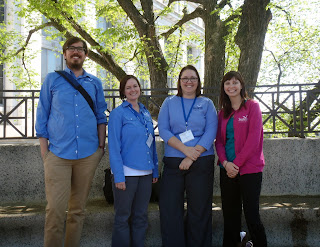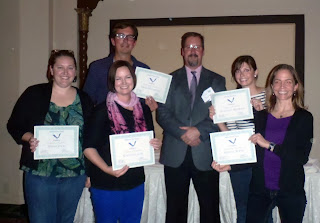Last year, Denise Devotta was selected as a John A. Knauss Fellow, an opportunity for a unique educational experience for students interested in national policy decisions affecting ocean, coastal and Great Lakes resources. Representing Illinois-Indiana Sea Grant, this University of Illinois graduate student was matched with a host in the Washington, D.C. area for a one-year paid fellowship. Here she reflects on her experiences.
The past year has been an adventure of a lifetime. My placement as a Knauss fellow in Congressman Jared Huffman’s office gave me firsthand experience of the ways in which the U.S. Congress creates and determines science policy. During my time there, I introduced seven pieces of legislation on Congressman Huffman’s behalf, drafted statements and questions for him for 46 Congressional hearings and five times when he spoke on the Floor of the U.S. House of Representatives (more commonly known as ‘the Floor’). I created vote recommendations for him, covering 47 pieces of environmental legislation. I met over 70 individual constituents, delegates from federal and state agencies, and representatives from non-profit organizations (including NOAA, the California Department of Forestry and Fire Protection, and the World Wildlife Fund) to discuss legislation pertaining to natural resource management in different parts of the country.

Denise Devotta (second from right) with the other 2017 Knauss fellows placed in Congressional offices, on the grounds of the U.S. Capitol in Washington, D.C.
Of all these incredible experiences, my favorites include staffing Congressman Huffman at Congressional hearings and on the Floor. Because Congressman Huffman is the most powerful Democrat on the Water, Power and Oceans Subcommittee, I helped draft his talking points and questions for witnesses at Congressional hearings on key pieces of legislation affecting oceans, fisheries and freshwater management nation-wide. Being Congressman Huffman’s primary staffer during debates on the National Marine Sanctuaries Act and the reauthorization of the Magnuson-Stevens Act were particularly thrilling. Staffing Congressman Huffman when he discussed legislation on the Floor involved similar responsibilities. The main difference stemmed from the types of points and questions I included in Congressman Huffman’s statement. These were more closely tailored toward issues that other Members of Congress were likely to raise during the debate on the Floor.

Denise Devotta (right) staffing Congressman Huffman on the Floor of the U.S. House of Representatives as he debated legislation concerning pesticide regulation in waterways.
Another highlight during my Knauss Fellowship year was visiting my boss’s beautiful district in Northern California in August 2017. I spent about two weeks travelling from San Francisco in the south to Eureka in the north, and I met with my boss’s constituents along the way to learn more about important natural resource management issues they were facing. Some of these issues included water management in the vineyards of Sonoma County, ocean acidification impacting oyster growing operations at Hog Island Oyster Company and forest fire issues in the Trinity Alps. In addition to this trip, the Knauss Fellowship funded my engagement in other professional development activities, including completing my PhD dissertation at the University of Illinois at Urbana-Champaign in Urbana, Illinois, attending the Ecological Society of America’s Annual Meeting in Portland, Oregon, and presenting at the University of Maryland Center for Environmental Science in Frostburg, Maryland.
My Fellowship has ended, but I am excited about starting work as a scientist for NOAA’s Coral Reef Watch Program in March 2018. Being a Knauss fellow in Congress has provided me with an invaluable network of contacts in science policy and research, and it has given me a rare skillset valuable to both fields. I am extremely grateful to NOAA’s Sea Grant program for giving me this opportunity, and strongly encourage eligible graduate and professional students to apply for the 2019 Fellowship class.
The National Sea Grant Program is celebrating its 50th anniversary this year and Illinois-Indiana Sea Grant (IISG) is looking back at its own origins through the eyes of its first leader.
In 1982, IISG had its modest beginnings as a small marine extension project, through a partnership of the University of Illinois, Purdue University, and the National Oceanic and Atmospheric Administration.
Robert Espeseth was at the helm from 1982 through 1994. Now a retired University of Illinois professor of leisure studies, he recalled those early years as both part happenstance and part destiny.
Like a star football quarterback recalling his glory days, he shared the play-by-play of the creation of IISG.
“Jim Peterson, who had a joint appointment with Purdue and Indiana, and I were up there at a Great Lakes regional workshop for recreation specialists in 1980,” Espeseth recalled. “And one of the fellows from Michigan was getting funding out of Michigan Sea Grant, and he said, ‘Have you guys ever looked into that?’ And we said, ‘What is it?’ And he said, ‘With Illinois and Indiana not being in the program they’re anxious to complete the Great Lakes for programs covering all the shoreline.’”

And with that exchange, the pursuit to “cover the shoreline” began.
Peterson and Espeseth were both going to be in Washington, so they decided to pay a visit the National Sea Grant Office in Silver Spring, Maryland.
They arrived without an appointment, but Espeseth wasn’t going to leave without meeting the director, and he had the perfect in.
It just so happened that the National Sea Grant Program director, the late Ned Ostenso, was a coxswain in the boat Espeseth rowed during his days at the University of Wisconsin.
“’He’s really busy, he wouldn’t have time,’” Espeseth recalled being told.
“I said, ‘Just call him and tell him Bob Espeseth is here.’ So he did and Ned said, ‘Bring him on up!’”
Ostesno encouraged Espeseth and Peterson and explained how anxious he was to get Illinois and Indiana onboard, but he warned that it would be a long process.

How right he was.
Their first application in 1981 was turned down for not having a strong research component and because the two universities, Purdue and Illinois, weren’t very supportive of the Sea Grant mission. It wasn’t until 1982 that IISG finally got approved as a marine extension project.
Yet, there was still some uncertainty about the focus and direction of the program.
Initially the emphasis was on aquaculture, recreation and shoreline tourism—topics that were not as popular with other Sea Grants. IISG really took off once it added more research-focused areas like invasive species, water quality and pollutants.
The outreach staff grew from a single specialist to a team of over 20, located at universities and agencies in the two states. In 1997, IISG was awarded College Program status by the U.S. Department of Commerce.
Espeseth smiled as he thought back to those early days.
“I just talked to Jim Peterson the other day and he said laughing, ‘Yeah, that was really a shot in the dark!’ But at the behest of our compatriot up there in Michigan, that’s how it got started.”
 Staff members from 20 different Sea Grant programs across the U.S. attended two Sea Grant Academy sessions this year (one week in April, and one in October). The academy was developed to give Sea Grant employees valuable training and professional development information in a variety of fields, benefiting their work and the work of all Sea Grant programs at large.
Staff members from 20 different Sea Grant programs across the U.S. attended two Sea Grant Academy sessions this year (one week in April, and one in October). The academy was developed to give Sea Grant employees valuable training and professional development information in a variety of fields, benefiting their work and the work of all Sea Grant programs at large.
Five staff members from Illinois-Indiana Sea Grant were able to attend, and participated in sessions ranging from the history of Sea Grant to project design and evaluation, social science training, time management, communicating the importance of ocean science to various audiences, and much more.
 IISG’s Danielle Hilbrich, Greg Hitzroth, Kristin TePas, Kara Salazar, and Sarah Zack were among the more than 40 Sea Grant professionals who completed both weeks of training and graduated from Sea Grant Academy with new information and skills to bring to their work protecting the Great Lakes.
IISG’s Danielle Hilbrich, Greg Hitzroth, Kristin TePas, Kara Salazar, and Sarah Zack were among the more than 40 Sea Grant professionals who completed both weeks of training and graduated from Sea Grant Academy with new information and skills to bring to their work protecting the Great Lakes.
“Sea Grant Academy was a really unique opportunity to meet people from around the country that are working on the same issues we are,” said Sarah. “I thought that it was a great way to foster both partnerships between programs and friendships between specialists. I really enjoyed meeting all the attendees and hearing all about the great work they’re doing.”
 And Kristin TePas wrote, “It was a great opportunity to connect with other Sea Grant specialists from around the country. Also, hosting the meeting in Duluth provided a great opportunity to showcase our freshwater coast and the issues surrounding the Great Lakes.”
And Kristin TePas wrote, “It was a great opportunity to connect with other Sea Grant specialists from around the country. Also, hosting the meeting in Duluth provided a great opportunity to showcase our freshwater coast and the issues surrounding the Great Lakes.”
To learn more about the National Sea Grant program and the work being done to protect America’s coastal resources, visit the NOAA Sea Grant webpage.






